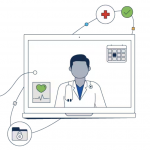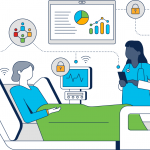While we grappled physically with COVID-19, donning masks and using hand sanitizer to protect ourselves against an unseen virus, another invisible pandemic was taking hold.
Behind snarky memes and jokes about too many wine bottles on the curb, lies a grim reality: the upheaval, isolation, fear, sadness, and uncertainty of the COVID-19 pandemic profoundly impacted mental health across the world. In the US alone, more than 32% of consumers reported experiencing anxiety or depression as a result of the pandemic.10
How we react to that impact could redefine our communities and help us move toward a healthier, more inclusive future. But first, we need to understand how deep our collective mental health issues run. Additionally, there are industries and communities unevenly impacted by the pandemic and we want – and need – to bring awareness to those bearing the brunt of the mental health toll.

Healthcare
The impact of the pandemic on healthcare workers can’t be overstated. Workers have battled an unpredictable disease for over 14 months, caring for the ill and witnessing unprecedented loss, and they are reaching a breaking point. More than 60% of healthcare workers stated that the pandemic has negatively affected their mental health with physicians, women in particular, experiencing staggering amounts of burnout.6,7 The increased demand on schedules caused some workers to report that even if they had access to mental health services, they couldn’t take the time from work to utilize them,6 adding one more barrier to seeking mental health services when they are needed most.

Education
Educators too have been asked to carry more than their share. In addition to reimagining education and pivoting overnight to distance learning, they have been tasked with leading their students through a time of crisis, caring for and curating their social and emotional needs. Under normal circumstances, educators are prone to burnout, even vicariously taking on trauma or secondary traumatic stress of students in crisis.8 The pandemic only intensified this with whole classrooms of students navigating anything from fear to grief. Reported burnout has almost doubled in educators, in that same study a shocking one quarter of teachers said they were likely to leave the profession after the 2020-21 school year.9

Communities and Government
In some ways, the COVID-19 pandemic is a generationally defining moment – an event we collectively experienced together. However, the pandemic put in stark relief the disparities that have always existed in our communities and on the world stage.
Immediately, minorities and women experienced more socio-economic ramifications from the global shutdowns.1 And as the months wore on, women stepped back or left the workforce in unprecedented numbers in order to shoulder childcare responsibilities.2 This has unsurprisingly had a huge impact on mental health for both demographics1, not to mention exacerbating existing disparities and shaking the foundation of potential future gains.
Both governments and employers have historically struggled to address the need for comprehensive mental health programs. And while overall the stigma around reaching out for help is declining – minority groups report more self-stigma and experience drastic disparity for mental health delivery.4,5 In a year that will be synonymous with racial and social justice causes, this again is one more area where systemic inequities leave the most vulnerable among us without the critical, life-saving services they deserve.
Cisco Addressing Mental Health
At Cisco we’re committed to creating an inclusive recovery and future for all – and we know better mental health programs as well as reducing the barriers and stigma attached to asking for help are key to that mission. Technology can play a huge role in creating access to care and building the connections necessary to create a healthier, more empathetic world.
In the last year, we’ve helped create robust virtual care programs for mental health providers – and closed the digital divide through the use of digital front door and patient outreach technologies. Seamless technologies are also taking education further and we’re helping empower educators with the right tools, helping them to fund and finance the platforms and systems they need to focus on their students – and themselves. As a company Cisco has been focused on ending the stigma surrounding mental health among our 75,000+ employees, and thus the global community. While COVID-19 has exacerbated an existing problem, we hope it’s a catalyst for awareness and change that was desperately needed before March 2020.
We all can do more to create a healthier world. Make sure to raise awareness about the challenges happening in our communities on your own social channels using #mentalhealthmatters and #mentalhealthwareness.
If you want to keep up-to-date on critical issues across industries, follow our #HealthcareNow, #EducationNow, #GovernmentNow series.
Sources
- Common Wealth Fund, 2020
- McKinsey, 2020
- McKinsey, 2021
- Rand Health Quarterly, 2017
- Mental Health Disparities: Diverse Populations
- HealthcareDive, 2021
- HealthcareDive, 2020
- www.ascd.org, 2021
- EducationWeek, 2021.
- PwC Health Research Institute consumer survey, September 2020


CONNECT WITH US